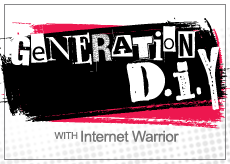Generation DIY: Songbook Safebox
posted in: Features

Ever get those bursts of inspiration that result in a handful of songs? Songs that your friends say are some of your best work and can’t get enough of? PROTECT THEM! This week’s Generation DIY talks about copyrighting your work, and no not the poor man’s way because that does NOT always work in your favor.
According to the US copyright laws, as well as the Berne Convention, artists own the rights to their songs the moment they are recorded, written down or created in a tangible format thus giving them ownership over their work. This constitutes as a type of poor-man’s copyright, which is different from registering with a work with the copyright office and doesn’t always hold up in court. The best advice for Generation DIY is to research and really try to understand copyright law, even if only on a superficial level. Protecting your work is the most important thing a musician can do. Without this security your career can be in jeopardy.
So first things first: Visit Copyright.gov to read about copyright law and learn exactly what you need to do to get covered. After gaining a small understanding of what needs to be done, the steps to copyright your work are quite simple. First you need to attain the proper forms, which can be found here. Next, fill them out correctly (this is most important, if there are discrepancies in your forms, your request will not be filed) and be sure to include the correct amount of money along with your music. Now mail it in. It’s THAT simple! Also, think about copyrighting your music as a collection rather than individual songs. Saving money is key to Generation DIY so try to keep that goal intact!
Over the years there have been numerous copyright infringement cases within the music industry. A large portion of these cases never go to court due to the expense and negative publicity. The recent a case between Joe Satriani and Coldplay is a good example of a copyright case being dismissed before going before a judge. Satriani filed a lawsuit against Coldplay’s label stating that their latest album’s title track “Viva La Vida” contained many elements from an instrumental track off his Is There Love In Space? album. With cases like this, music theorists are brought in to examine the pieces of music and pinpoint between similarities to determine if a piece of music was derived from another source. In all likelihood, a large monetary settlement behind the scenes allowed Coldplay, who denied the allegation, to keep their reputation intact.
In conclusion, make sure your song, lyrics or music are saved in a tangible medium (CD, tape, mp3, whatever it may be), somewhere it can be time stamped. Also, file your work with the proper copyright office and save all documentation of your filing. This is something I can’t stress enough. Don’t make the mistake of thinking your music is free & clear of being stolen just because you have it written down or saved somewhere. Although the Berne Convention states this is enough, having official documentation is great leverage if a case is brought on. If you cover what was stated in this post you will be on the right path of keeping your songbook safe from all those money hungry moochers out there.
As always, research and become familiar with the concept of copyrighting your music, as there are many great sites out there. The ones I gave in the post above are a good start but don’t stop there, always put the effort in to further investigate. Remember, this is your future and your career. Don’t let someone steal that from you.
Until next time Generation DIY! Keep that hustle strong. This is YOUR year.
